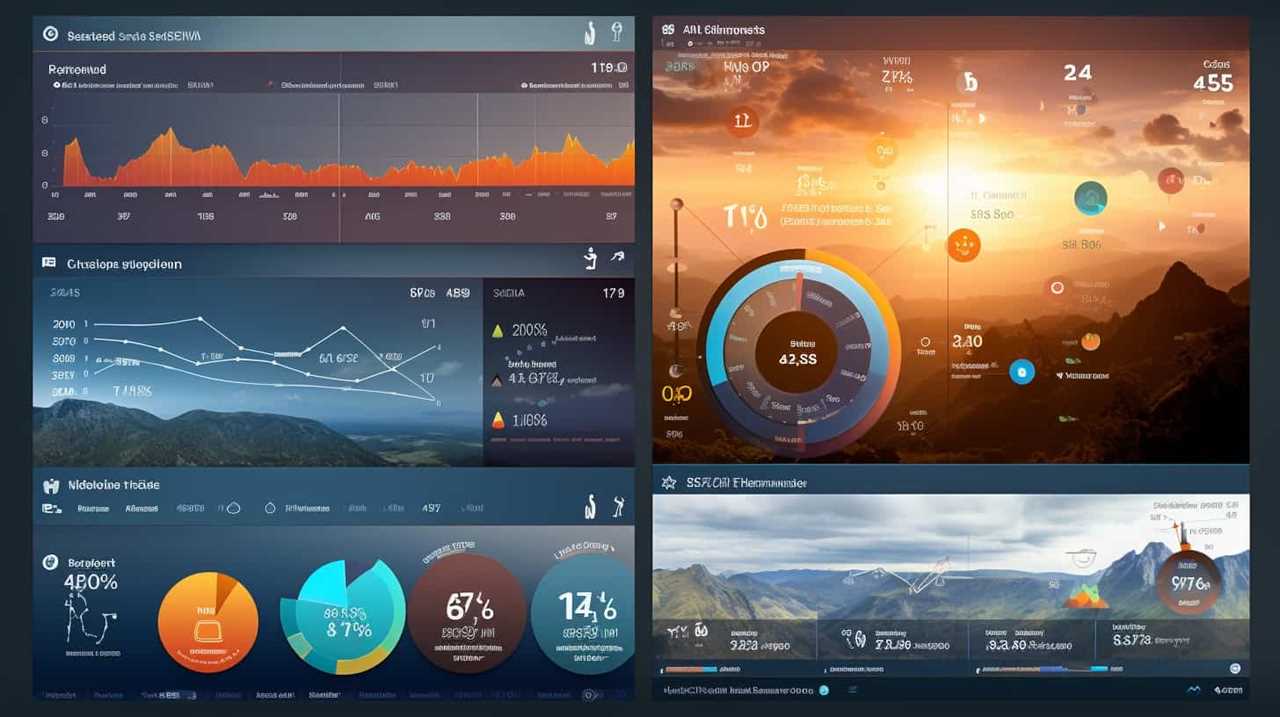It’s common knowledge that SEO plays a crucial role, but are you truly familiar with the significance of H2 and H3 tags?
In this article, we’ll dive into the basics of H2 and H3 headings and their significance in search engine optimization. We’ll explore how search engines interpret these headings and provide you with best practices for using them effectively.
So, if you’re looking to master the art of SEO, understanding H2 and H3 is a crucial step.
Let’s get started!

Key Takeaways
- H2 and H3 tags structure content and provide hierarchy to a page, improving readability and organization.
- Optimizing H2 and H3 tags enhances SEO performance and user experience by establishing a clear content hierarchy.
- Relevant keywords in H2 and H3 tags signal important topics to search engines, improving search engine rankings and visibility.
- Proper formatting and keyword optimization of H2 and H3 headings are crucial for SEO optimization and content understanding by search engines.
Understanding the Basics of H2 and H3
In this section, we’ll delve into the fundamentals of H2 and H3, providing a comprehensive understanding of their importance in SEO.
Header tag optimization plays a crucial role in improving the overall user experience on a website. H2 and H3 tags are HTML elements that help structure content and provide hierarchy to the page. By using these tags correctly, you can enhance the readability and organization of your content, making it easier for both search engines and users to navigate.
Additionally, H2 and H3 tags can have a significant impact on user experience by breaking up the text into smaller, more digestible sections, improving readability and engagement.
Optimizing H2 and H3 tags is essential for improving your website’s SEO performance and ensuring a positive user experience.

Importance of H2 and H3 in SEO
When it comes to SEO, understanding the importance of H2 and H3 header tags is crucial. These header tags not only provide a hierarchy for your content, but they also serve as important SEO ranking factors.
Header Tag Hierarchy
We prioritize the use of H2 and H3 header tags in SEO to establish a clear and structured hierarchy for our content. Header tag optimization plays a crucial role in creating an effective header structure that not only improves user experience but also helps search engines understand the organization of our webpage.
By using H2 tags for main headings and H3 tags for subheadings, we ensure that our content is well-organized and easy to navigate. This hierarchy allows search engines to identify the most important topics on our page, improving the chances of our content being displayed prominently in search results.
SEO Ranking Factors
Continuing from the previous subtopic, our content benefits from the clear hierarchy established by H2 and H3 header tags in SEO, which contribute to the importance of SEO ranking factors.

Header tag optimization plays a crucial role in improving search engine rankings and user experience. When properly used, H2 and H3 tags help organize content and make it easier for search engines to understand the structure of a webpage.
This, in turn, improves the overall user experience by making the content more scannable and readable. By strategically incorporating relevant keywords into H2 and H3 tags, we can signal to search engines the main topics and subtopics of our content, further enhancing our chances of ranking higher in search results.
Therefore, it’s essential to optimize header tags to maximize the impact on both SEO and user experience.
Structuring Content for Optimization
To optimize content for improved search engine rankings and user experience, it’s crucial to understand the importance of H2 and H3 header tags in SEO. Structuring content using these header tags not only helps search engines understand the hierarchy and organization of your page but also improves readability and user engagement.

Here are three key reasons why structuring content with H2 and H3 tags is essential for SEO optimization:
- Hierarchy and organization: Using H2 and H3 tags allows search engines to understand the structure and organization of your content, making it easier for them to index and rank your page.
- Keyword optimization: By incorporating relevant keywords in your H2 and H3 tags, you can signal to search engines the main topics and subtopics of your content, improving its visibility in search results.
- User experience: Structuring your content with clear headings not only helps search engines but also enhances the user experience by making it easier for visitors to navigate and scan your page.
How Search Engines Interpret H2 and H3
As search engines crawl and index web pages, they interpret the usage of H2 and H3 headings to understand the organization and hierarchy of the content. These headings provide valuable signals to search engines about the importance and relevance of the content within them. To optimize H2 and H3 headings for SEO, it is important to format them properly. Here are some tips for optimizing H2 and H3 headings:
- Use relevant keywords: Incorporate target keywords in your headings to help search engines understand the topic of the content.
- Maintain hierarchy: Use H2 headings for main sections and H3 headings for subtopics within those sections. This helps search engines understand the structure of your content.
- Keep it concise: Make sure your headings are clear, concise, and accurately represent the content beneath them.
By following these tips, you can enhance the SEO value of your H2 and H3 headings and improve the visibility of your content in search engine results.
| Tips for Optimizing H2 and H3 Headings |
|---|
| Use relevant keywords |
| Maintain hierarchy |
| Keep it concise |
Best Practices for Using H2 and H3 Headings
We recommend incorporating relevant keywords and maintaining hierarchy when using H2 and H3 headings for optimal SEO performance.

To help you make the most out of these headings, here are some best practices for formatting H2 and H3:
- Use descriptive and keyword-rich headings: Ensure that your H2 and H3 headings accurately reflect the content they introduce, incorporating relevant keywords to improve search engine visibility.
- Maintain a hierarchical structure: Organize your headings in a logical and hierarchical manner, with H2 headings representing main sections and H3 headings for subsections.
- Optimize for mobile devices: With the increasing use of mobile devices, it’s crucial to ensure that your H2 and H3 headings are easily readable and responsive on smaller screens. Consider using shorter headings and testing their appearance on different devices.
Optimizing H2 and H3 for Keywords
When optimizing H2 and H3 headings for keywords, it’s important to ensure that they accurately reflect the content they introduce and incorporate relevant keywords for improved search engine visibility.
Optimizing header tags involves strategically placing keywords within the headings to signal to search engines the relevance and focus of the content. By incorporating keywords in the headings, it becomes easier for search engines to understand the main topics discussed on a webpage. This can ultimately lead to higher rankings in search engine results pages and increased visibility for the webpage.
Additionally, optimizing header tags can also improve the overall user experience by providing clear and organized content.

Now that we understand the importance of optimizing H2 and H3 headings for keywords, let’s move on to the next section where we discuss using H2 and H3 for content organization.
Using H2 and H3 for Content Organization
To further enhance the organization of our content, let’s explore how to effectively utilize H2 and H3 headings. These heading tags not only help in structuring our content but also provide SEO benefits.
Here’s how we can use H2 and H3 headings for content organization:
- Hierarchy: H2 tags should be used for main headings, while H3 tags can be used for subheadings within the main sections.
- Readability: By using descriptive headings, we make it easier for our audience to navigate through our content and understand its structure.
- SEO Optimization: Search engines prioritize headings when crawling websites, so using H2 and H3 tags with relevant keywords can improve our visibility in search results.
Common Mistakes to Avoid With H2 and H3
When it comes to using H2 and H3 headers, there are a few common mistakes to avoid.

One of the main mistakes isn’t following the proper header hierarchy, which can make it difficult for search engines to understand the structure of your content.
Another mistake isn’t optimizing your headers with relevant keywords, which can impact your SEO efforts.
Proper Header Hierarchy
One common mistake to avoid with H2 and H3 headers is using an incorrect header hierarchy. To ensure proper header usage and an effective header structure, consider the following:
- Start with H1: Always begin with an H1 header as the main heading of your page.
- Use H2 for sections: Use H2 headers to divide your content into meaningful sections.
- Use H3 for subsections: Use H3 headers to further break down your content into subtopics within each section.
By following this hierarchy, you create a clear and organized structure for your content, making it easier for search engines and readers to understand.

Keyword Optimization Techniques
In the article ‘What Is H2 and H3 in SEO’, we’ll now delve into the topic of ‘Keyword Optimization Techniques (Common Mistakes to Avoid With H2 and H3)’.
By exploring effective strategies for maximizing keywords within H2 and H3 headers, keyword optimization is crucial for improving search engine rankings and driving organic traffic to your website.
To ensure success, it’s essential to conduct thorough keyword research to identify relevant and high-performing keywords. Once you have identified the right keywords, incorporate them strategically within your H2 and H3 headers to enhance on-page optimization.
However, it’s important to avoid common mistakes such as keyword stuffing or using unrelated keywords. By following these techniques, you can optimize your content and improve your website’s visibility in search engine results.

Tracking and Analyzing H2 and H3 Performance
We track and analyze the performance of H2 and H3 headings using various metrics and tools.
When it comes to tracking analytics and performance metrics of H2 and H3 headings, we rely on the following:
- Click-through rate (CTR): We monitor the number of clicks on our H2 and H3 headings to gauge their effectiveness in driving traffic.
- Bounce rate: We analyze the bounce rate of pages with H2 and H3 headings to assess if they’re engaging enough to retain visitors.
- Conversion rate: We track the conversion rate of pages with H2 and H3 headings to measure their impact on achieving our goals.
Frequently Asked Questions
How Do H2 and H3 Headings Affect Website Rankings in Search Engines?
H2 and H3 headings play a crucial role in website rankings and click through rates. Optimizing keywords in these headings is important for SEO success. They help search engines understand content and improve user experience.
Can H2 and H3 Headings Be Used Interchangeably or Do They Serve Different Purposes?
H2 and H3 headings are important for proper heading structure in SEO. They cannot be used interchangeably as they serve different purposes. To optimize H2 and H3 headings for better search engine rankings, follow these strategies.

Is There a Limit to the Number of H2 and H3 Headings That Should Be Used on a Webpage?
There’s no way around it: too many H2 and H3 headings can seriously mess with your webpage’s SEO. It’s crucial to maintain a proper hierarchy and limit their use for optimal results.
Do H2 and H3 Headings Impact the User Experience on a Website?
H2 and H3 headings play a crucial role in website design. They improve user experience by organizing content and making it easier to navigate. To optimize for SEO, follow best practices like using relevant keywords.
Are There Any Specific HTML Tags or Attributes That Should Be Used With H2 and H3 Headings for Better Seo?
When it comes to optimizing H2 and H3 headings for SEO, using specific HTML tags and attributes is crucial. Proper heading structure is of utmost importance and following best practices can help boost search engine visibility.
Conclusion
In conclusion, H2 and H3 headings play a crucial role in SEO success. They help search engines understand the structure and relevance of your content. By optimizing H2 and H3 headings with keywords and organizing your content effectively, you can improve your website’s visibility and ranking.

However, it’s important to avoid common mistakes and track the performance of your headings to ensure they’re delivering the desired results. So, remember to harness the power of H2 and H3 for SEO success.










